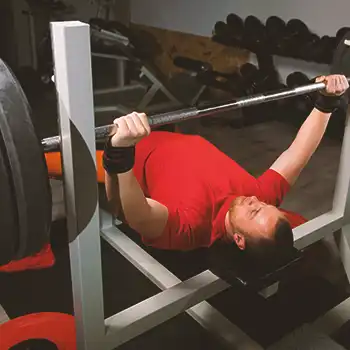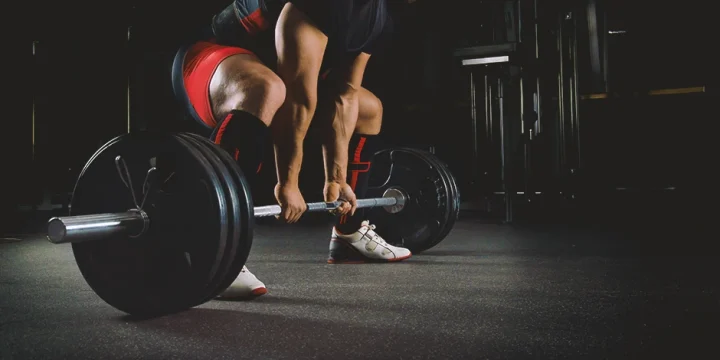Building muscle isn’t as easy as it seems, and there is a lot of science behind becoming anabolic and inducing the most significant hypertrophy effects.
However, an appropriate muscle-building workout will get you halfway there, assuming you correctly nail the reps, sets, rest intervals, volume, intensity, and frequency.
As a certified personal trainer and based on my 40-hour research, I created the best gym workout routine for building muscle and hypertrophy effects.
After reading the article, you will know the whole workout, how to perform it, and what is the best supplement to keep the progress over a prolonged period.
Quick Summary
- The best workout routine to build muscle consists of pushing, pulling, and leg days, which contain exercises such as bend press, overhead press, pull-ups, rows, squats, deadlifts, lunges, split squats, and ab exercises.
- Incorporating a mix of compound and isolation exercises, with specific focus on different muscle groups each day, optimizes muscle growth and overall body strength.
- According to the National Institute of Health, progressive overload is the most effective method for hypertrophy training and maintaining an anabolic state over extended periods.
- In my opinion, consistency and dedication to the routine, along with proper nutrition and rest, are crucial for achieving significant muscle growth and body transformation.
Example Gym Workout Routine to Build Muscle

To get the most out of every workout, you must include some principles, such as the one of progressive overload, to keep building muscle.
According to a study by the National Institute of Health (NIH), this has been proven to be the most effective for hypertrophy training and staying anabolic for prolonged periods [1].
However, you also must include enough rest and recovery periods, which, according to NIH, will prevent the overtraining syndrome from occurring [2].
I advise sticking to 48-72 hours of rest between workouts targeting the same muscle group to ensure proper rest and recovery,
"A split routine allows one to train the entire body, broken up by body parts, throughout the week compared to an all-in-one workout like a full-body workout would have you do. Focusing on muscle groups each day has its benefits. Focusing on a specific muscle or two per training session means you can attack the area(s) with more overall volume instead of partitioning your energy across a full-body workout."
- Ben Pollack, Certified Personal Trainer
Day 1: Push

Day one is the “pushing” day, which means all the exercises will fit the horizontal or vertical pushing motions.
On this particular day, we will focus on compound movements for most of the workout, and then we will finish the workout with some additional pushing isolation exercises.
Here is the entire workout:
- Barbell bench press - Perform 8 reps for 4 sets, and rest between 2 and 5 minutes between the sets.
- Barbell military press - Complete 8 reps for 4 sets and rest for about three minutes between the sets.
- Dumbbell incline press - Perform 10 reps for 3 sets, and rest for 2 minutes between the sets.
- Dumbbell lateral raises - Complete 12 reps for 3 sets, and rest between 30 and 90 seconds between the sets.
- Dumbbell tricep extensions - Perform 12 reps for 3 sets, and rest between 30 and 90 seconds between the sets.
Related: Push Day Workout
Day 2: Pull
Day two of the week focuses on “pulling” movements, which are vertical and horizontal pulling motions.
These exercises are perfect for strengthening your posterior chain muscles, especially those of your back.
Here is the entire workout:
- Barbell deadlifts - Perform 8 reps for 4 sets, and rest between 2 and 5 minutes between the sets.
- Barbell bent over rows - Complete 8 reps for 4 sets and rest for about three minutes between the sets.
- Lat pulldowns - Perform 10 reps for 3 sets, and rest for 2 minutes between the sets.
- Dumbbell upright rows - Complete 12 reps for 3 sets, and rest between 30 and 90 seconds between the sets.
- Dumbbell single arm bicep curls - Perform 12 reps for 3 sets, and rest between 30 and 90 seconds between the sets.
Also Read: Best Pull Workouts
Day 3: Legs

Day three will combine pushing and pulling motions to create the perfect leg workout, featuring a variety of leg exercises.
These exercises will strengthen anterior and posterior chain muscles, ensuring you holistically build strength.
Here is the entire workout:
- Barbell squats - Perform 8 reps for 4 sets, and rest between 2 and 5 minutes between the sets.
- Bulgarian split squat - Complete 8 reps for 4 sets and rest for about three minutes between the sets.
- Leg press - Perform 10 reps for 3 sets, and rest for 2 minutes between the sets.
- Leg extensions - Complete 12 reps for 3 sets, and rest between 30 and 90 seconds between the sets.
- Standing calf raises - Perform 12 reps for 3 sets and rest between 30 and 90 seconds between the sets.
Day 4: Push
Day four is again when we do all the pushing movements in a single workout.
Here is the entire workout:
- Push-ups - Perform 12 reps for 4 sets, and rest between 2 and 5 minutes between the sets.
- Barbell incline bench press - Complete 8 reps for 4 sets and rest for about three minutes between the sets.
- Dumbbell shoulder press - Perform 10 reps for 3 sets, and rest for 2 minutes between the sets.
- Tricep pushdowns - Complete 12 reps for 3 sets, and rest between 30 and 90 seconds between the sets.
Day 5: Pull

The fifth day will already be very challenging since it is the end of the week, and the volume accumulated from day 1.
You want to be as fresh as possible for this workout since keeping the intensity high enough without being concentrated is a recipe for disaster.
This causes the biggest amount of injuries in strength training.
Here is the entire workout:
- Pull-ups - Perform 8 reps for 4 sets, and rest between 2 and 5 minutes between the sets.
- Seated cable row - Complete 8 reps for 4 sets and rest for about three minutes between the sets.
- Face pulls - Perform 10 reps for 3 sets, and rest for 2 minutes between the sets.
- Barbell bicep curl - Complete 12 reps for 3 sets, and rest between 30 and 90 seconds between the sets.
- Barbell good mornings - Perform 12 reps for 3 sets and rest between 30 and 90 seconds between the sets.
Day 6: Legs
Day six is the last workout day in the week before you take a small but very important rest and recovery period.
Here is the entire leg workout for day 6:
- Goblet squats - Perform 8 reps for 4 sets, and rest between 2 and 5 minutes between the sets.
- Lunges - Complete 8 reps for 4 sets and rest for about three minutes between the sets.
- Hip thrust - Perform 10 reps for 3 sets, and rest for 2 minutes between the sets.
- Romanian deadlifts - Complete 12 reps for 3 sets, and rest between 30 and 90 seconds between the sets.
- Glute kickbacks - Perform 12 reps for 3 sets and rest between 30 and 90 seconds between the sets.
Related Articles:
Day 7: Rest and Recovery

Rest and recovery are crucial for staying anabolic and experiencing the best hypertrophy effects.
To rest and recover on day seven, you should include passive and active rest activities. Walking, jogging, and low-intensity recreational sports are all recommended on day 7.
However, for some people, it is just better to do nothing and completely and passively rest all day before starting the new workout week.
Pick the one that suits you best, or combine both options if you feel that might enable you to recover faster and be fresh for the upcoming week.
How Often and How Much Should You Work Out to Gain Muscle?
You should work out at least 3 times a week to gain muscle.
These three workout sessions must cover all body parts, meaning you should split them into push, pull, and leg days.
Also, if you only have three weekly workout sessions, you must keep the workout intensity high since that is the best way to compensate for additional workouts.
I've found that training my clients 4 times a week is optimal for consistently building muscle. However, I always emphasize that a minimum of three weekly workout sessions is crucial, as anything less may not suffice for sustained muscle growth over time.
"Muscle growth starts in the gym. You damage the muscle fibers with resistance training; whether that’s with your own bodyweight or heavy iron. (3) Then, your body fuses the fibers back together during the recovery period, which helps make them bigger. This is called hypertrophy, or the enlargement of muscle tissue."
- Anthony O'Reilly, Certified Personal Trainer
How to Program Workout Routine to Build Muscle?

To program a workout routine to build muscle, you must incorporate hypertrophy training and progressive overload principles.
Progressive overload is the training methodology to increase your strength and build muscles. It is based on continually increasing the intensity, total training volume, or external resistance for each following workout.
In addition, progressive overload is the only proven way to gain strength, and since strength and hypertrophy are linked, you should strictly follow that principle.
Hypertrophy training principles can be divided into a couple of rules, and you can find those below:
- Sets - The number of sets for a single exercise should never be less than 3, preferably equal to or more than 4.
- Reps - The rep range you should strictly follow to gain the most significant amount of muscles is between 6 and 12. This has been proven to have the best ratio for anabolic/catabolic metabolism, allowing for the best recovery during workouts.
- Rest intervals - The rest intervals between the sets should always be between 30 and 90 seconds. Less than 30 seconds build endurance; more than 90 seconds will be better for strength training than hypertrophy.
- Intensity - The ideal percentage of 1 rep max for hypertrophy doesn’t exist, but the range of 60-80% has been proven the best.
- Frequency - Two weekly sessions are only acceptable for beginners, and anything below three weekly workouts won’t be enough for intermediate and advanced lifters.
- Type - The methods you should use for hypertrophy will be described in the sections below, but the best ones include multiple sets, supersets, compound sets, and heavy negatives.
How to Warm Up for a Muscle-Building Workout?

To warm up for a muscle-building workout routine, you should do the following:
- Foam rolling + PNF stretching - Start your warm-up with gentle foam rolling the most important muscle groups and then include PNF stretches for the same muscle groups too.
- Cardio activity - Jump on a treadmill and run for 3-4 minutes to raise your body’s temperature.
- Dynamic stretching - Perform a set of exercises based on the dynamic stretching training methodology for 10 minutes.
- Activation - Activate and warm-up specific muscle groups that will be targeted that day.
The Best Methods for Muscle Hypertrophy Training

As a personal trainer, I've found that the most effective methods for muscle hypertrophy training with my clients include multiple sets, supersets, compound sets, and heavy negatives.
Let's explore each method briefly in the sections below based on our experiences.
Multiple Sets
The multiple-sets method means performing more than one set for a single exercise with predefined rest intervals, reps, and a percentage of 1RM (repetition maximum).
Multiple sets are one of the fundamental and most popular lifting and strength training methods.
It is also excellent for hypertrophy because you can easily ram up the overall training volume for a specific muscle group by continually performing sets with proper rest intervals for the same muscle group.
Supersets
Supersets are a hypertrophy training method that encompasses performing 2 different exercises, one after the other, with no rest in between.
Also, you almost always pair the exercises based on the agonist/antagonist relationship.
For example, bench presses, bicep curls, pull-ups, and tricep extensions are excellent examples of supersets.
You can feel free to play with the exercises as long as you don’t hit the same muscle groups in both exercises since that is a compound sets methodology.
Compound Sets

Compound sets are the advanced hypertrophy method best described as performing biomechanically similar exercises targeting the same muscle groups one after another.
This means, for example, performing bent-over rows, one-arm cable rows, and biceps curls one after another.
Compound sets are the best for continually forcing the muscle to adapt since the overall intensity and training volume are so high with this hypertrophy method.
Heavy Negatives
Heavy negatives is a popular strength training method where you put more weight than you can perform concentrically on the eccentric phase of muscle contraction.
This means, for example, if your 1RM for a squat is 100kg, you can put 105kg and only do the lowering portion of the squat.
However, the downside of this method is that the reps are low, and you will almost always need distinct help from a partner since you can easily get injured if you try performing alone.
Nutritional Strategies for Muscle Hypertrophy
To support muscle growth, focus on a balanced diet rich in protein, the building block of muscles.
- Aim for 1.6-2.2 grams of protein per kilogram of body weight daily, sourced from lean meats, fish, dairy, and plant-based options like beans and lentils.
- Carbohydrates are crucial for energy; opt for whole grains, fruits, and vegetables.
- Healthy fats from nuts, seeds, and avocados aid hormone production and nutrient absorption.
- Hydration is key, so drink plenty of water.
- Post-workout, consume a mix of protein and carbs to aid recovery.
- Finally, consider timing your meals to fuel workouts and aid recovery effectively.
FAQs
How Many Workouts a Week to Build Muscle?
You should do at least 3 workouts a week to build muscle. To continually build muscle mass and induce the most significant muscle growth, you must have at least three high-intensity weightlifting sessions consisting of isolation exercises and compound movements.
Is Working Out 30 Minutes a Day Enough to Build Muscle?
It depends on your intensity and training volume if working out 30 minutes a day is enough to build muscle. To build lower body and upper body strength and lean muscle mass, you must hit every muscle group with enough training volume so the hypertrophy effects can take place after the workout.
How to Bulk up in 30 Days?
To bulk up in 30 days, you must participate in a high-intensity hypertrophy-focused workout regimen. In addition, you must have a healthy diet and proper supplementation to ensure you burn fat and boost muscle gain during the supercompensation effect that takes place between two separate workouts.
Is Weightlifting 4 Times a Week Enough?
Most of the time, weightlifting 4 times a week is enough. If your workouts meet the necessary intensity and volume, you can easily induce muscle-building effects and keep losing body fat with 4 weightlifting sessions a week.
How Many Rest Days a Week?
You need to have at least 1 rest day a week. Rest days are crucial for recovery and enabling muscle-building effects to occur, and they will be efficient also for central nervous system (CNS) recovery so you can keep hammering your workouts with the same intensity every week.
What Is the Best Supplement for Building Muscle and Hypertrophy Workouts?
The best supplement for building muscle and hypertrophy workouts is a high-quality whey protein powder.
Nothing is better for muscle growth and post-workout anabolic metabolism than whey protein powder.
Whey protein powder, like casein as well, is a derivative of milk, and it quickly enters the bloodstream after workouts to ensure your body keeps being anabolic immediately.
If you want to pick the best whey protein powder, read these guides below, which will guide you through choosing the best protein powder product based on your needs and goals:
Let me know your thoughts on the best workout plan to build muscle.
References:
- https://www.ncbi.nlm.nih.gov/pmc/articles/PMC6950543/
- https://www.ncbi.nlm.nih.gov/pmc/articles/PMC3435910/
About The Author
You May Also Like






